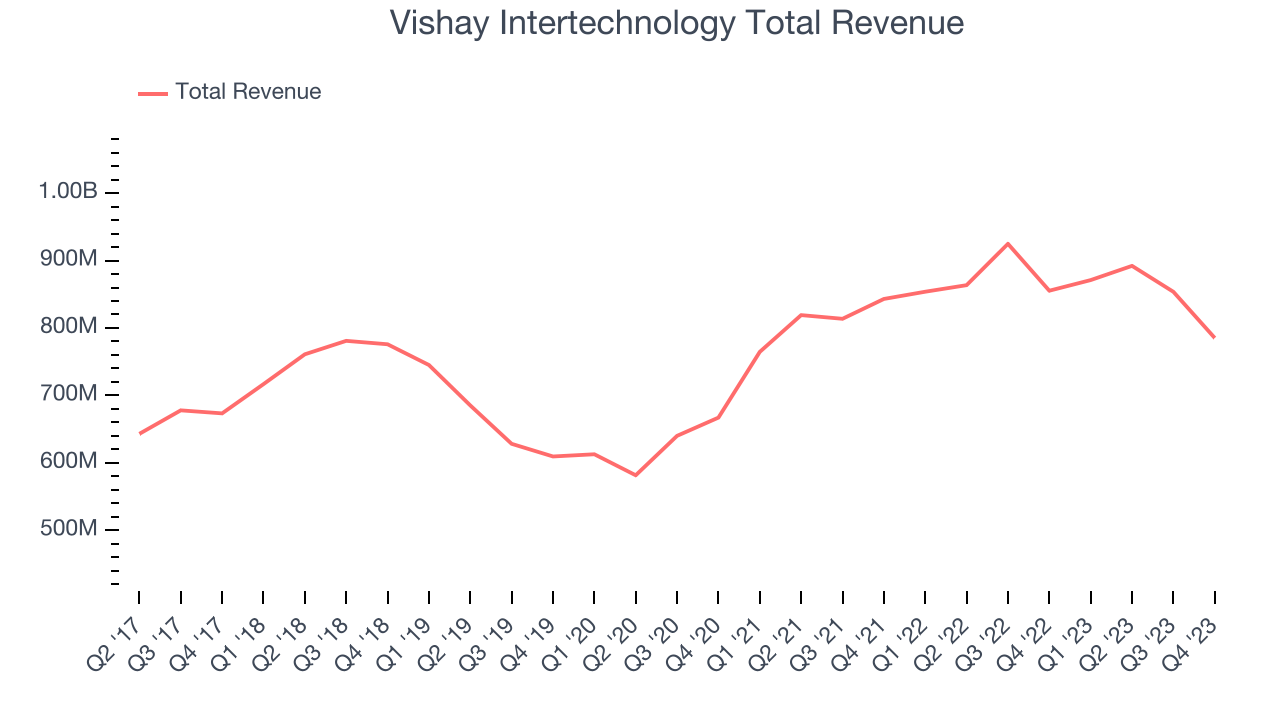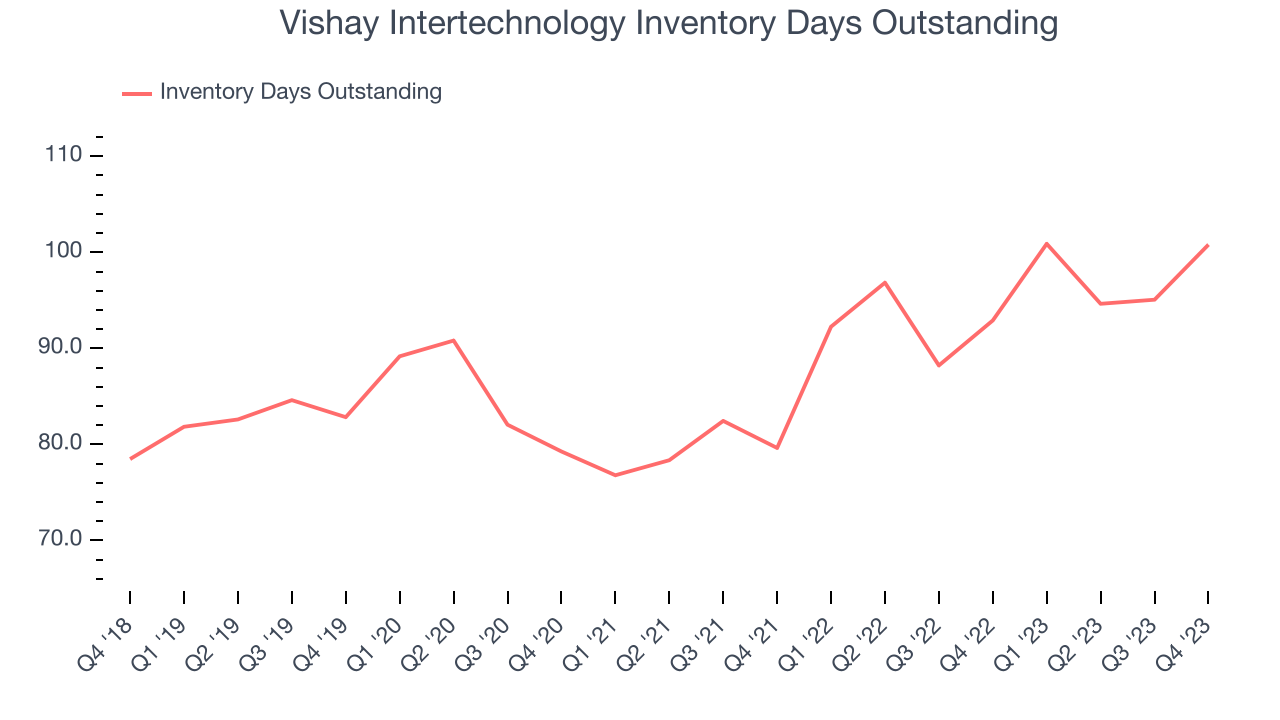Semiconductor manufacturer Vishay Intertechnology (NYSE:VSH) reported results in line with analysts' expectations in Q4 FY2023, with revenue down 8.2% year on year to $785.2 million. On the other hand, next quarter's revenue guidance of $735 million was less impressive, coming in 5.5% below analysts' estimates. It made a non-GAAP profit of $0.37 per share, down from its profit of $0.69 per share in the same quarter last year.
Is now the time to buy Vishay Intertechnology? Find out by accessing our full research report, it's free.
Vishay Intertechnology (VSH) Q4 FY2023 Highlights:
- Revenue: $785.2 million vs analyst estimates of $788.2 million (small miss)
- EPS (non-GAAP): $0.37 vs analyst estimates of $0.37 (small beat)
- Revenue Guidance for Q1 2024 is $735 million at the midpoint, below analyst estimates of $777.7 million
- Free Cash Flow was -$138.9 million, down from $55.5 million in the previous quarter
- Inventory Days Outstanding: 101, up from 95 in the previous quarter
- Gross Margin (GAAP): 25.6%, down from 29.1% in the same quarter last year
- Market Capitalization: $2.99 billion
“For the fourth quarter, the trends in inventory adjustments, contracting lead times and softened demand in industrial end markets became more apparent. While customers continue to digest higher inventory levels, we proceeded to implement our strategy to broaden participation with our distribution partners,” said Joel Smejkal, President and Chief Executive Officer.
Named after the founder's ancestral village in present-day Lithuania, Vishay Intertechnology (NYSE:VSH) manufactures simple chips and electronic components that are building blocks of virtually all types of electronic devices.
Analog Semiconductors
Demand for analog chips is generally linked to the overall level of economic growth, as analog chips serve as the building blocks of most electronic goods and equipment. Unlike digital chip designers, analog chip makers tend to produce the majority of their own chips, as analog chip production does not require expensive leading edge nodes. Less dependent on major secular growth drivers, analog product cycles are much longer, often 5-7 years.
Sales Growth
Vishay Intertechnology's revenue growth over the last three years has been unremarkable, averaging 11.7% annually. This quarter, its revenue declined from $855.3 million in the same quarter last year to $785.2 million. Semiconductors are a cyclical industry, and long-term investors should be prepared for periods of high growth followed by periods of revenue contractions (which can sometimes offer opportune times to buy).

Vishay Intertechnology had a difficult quarter as revenue dropped 8.2% year on year, missing analysts' estimates by 0.4%. This could mean that the current downcycle is deepening.
Vishay Intertechnology looks like it's headed into the trough of the semiconductor cycle, as it's guiding for a year-on-year revenue decline of 15.6% next quarter. Analysts are also estimating a 3.2% decline over the next 12 months.
When a company has more cash than it knows what to do with, buying back its own shares can make a lot of sense–as long as the price is right. Luckily, we’ve found one, a low-priced stock that is gushing free cash flow AND buying back shares. Click here to claim your Special Free Report on a fallen angel growth story that is already recovering from a setback.
Product Demand & Outstanding Inventory
Days Inventory Outstanding (DIO) is an important metric for chipmakers, as it reflects a business' capital intensity and the cyclical nature of semiconductor supply and demand. In a tight supply environment, inventories tend to be stable, allowing chipmakers to exert pricing power. Steadily increasing DIO can be a warning sign that demand is weak, and if inventories continue to rise, the company may have to downsize production.

This quarter, Vishay Intertechnology's DIO came in at 101, which is 13 days above its five-year average, suggesting that the company's inventory has grown to higher levels than we've seen in the past.
Key Takeaways from Vishay Intertechnology's Q4 Results
Despite a small revenue miss, EPS beat by a small amount. However, the company's revenue guidance for next quarter missed analysts' expectations and its gross margin shrunk. Overall, this was a mixed quarter for Vishay Intertechnology with weak outlook likely weighing on shares. The company is down 3.9% on the results and currently trades at $20.73 per share.
Vishay Intertechnology may not have had the best quarter, but does that create an opportunity to invest right now? When making that decision, it's important to consider its valuation, business qualities, as well as what has happened in the latest quarter. We cover that in our actionable full research report which you can read here, it's free.
One way to find opportunities in the market is to watch for generational shifts in the economy. Almost every company is slowly finding itself becoming a technology company and facing cybersecurity risks and as a result, the demand for cloud-native cybersecurity is skyrocketing. This company is leading a massive technological shift in the industry and with revenue growth of 50% year on year and best-in-class SaaS metrics it should definitely be on your radar.
